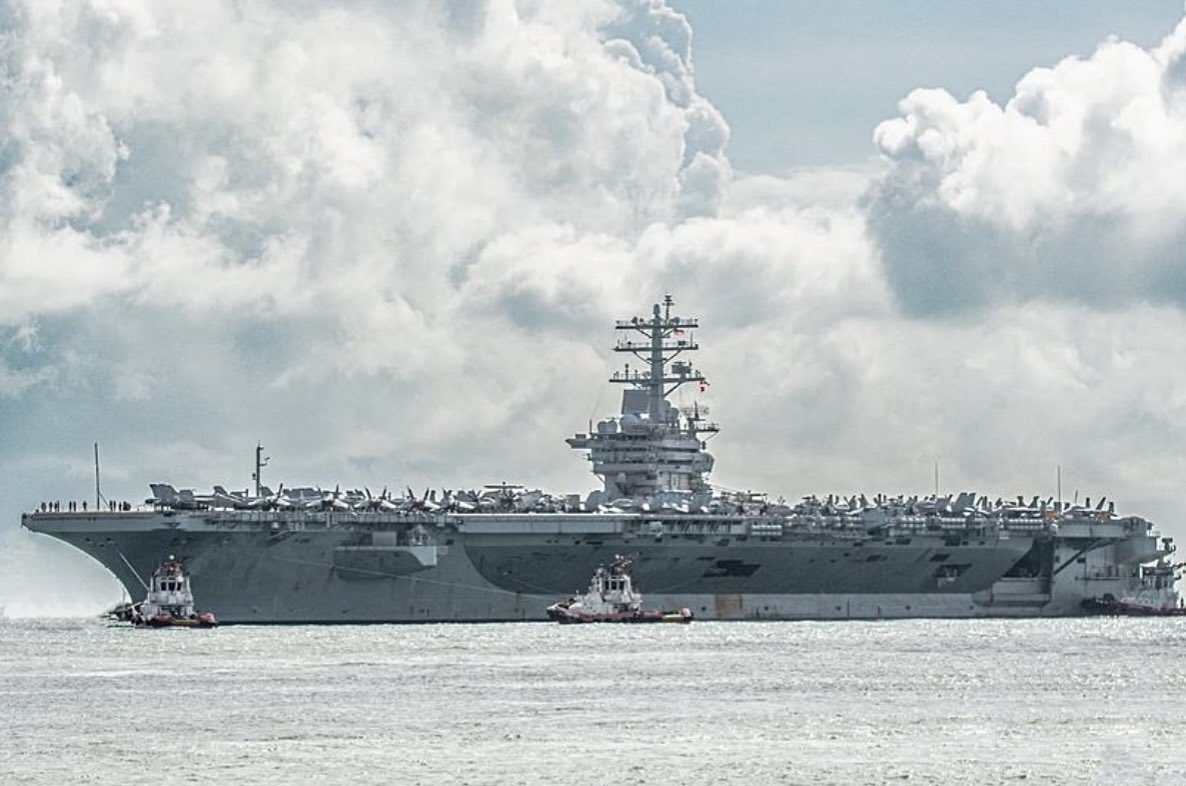China has released a video featuring its second aircraft carrier Shandong conducting a training exercise and making announcements in English, which according to a Chinese military expert, could mean that the aircraft carrier had “a close encounter with a US aircraft carrier in the South China Sea.”
-
Shortage Of Fighter Pilots Crippling Ukraine Even As Zelenskyy Pleads For Western Jets: Russia’s PMC Wagner
-
Despite NASAMS, Kyiv Says Russia Is ‘Deceiving’ Ukrainian Defenses By Using Decoy Missiles & Balloons
The People’s Liberation Army Navy (PLA Navy) released footage on February 16 showing the Shandong aircraft carrier conducting drills in the South China Sea, with the J-15 fighter jets performing take-off and landing operations.
In the video, a crew member is heard announcing, “This is Chinese navy warship 17,” in both Chinese and English.
“It gives people an overwhelming sense of security,” the PLA Navy described the Shandong’s words on its official WeChat account.
In 2021, the Type 055 large destroyer Nanchang took part in the China-Russia maritime joint exercise and cruise, during which the crew member of Nanchang identified themselves to other ships and aircraft in English, saying, “I am a Chinese Navy 101, I am sailing, keep a safe distance from me.”
PLA Navy releases the video—Chinese aircraft carrier Shandong carries out exercises in the South China Sea. pic.twitter.com/oocRDZGXf6
— SCS Probing Initiative (@SCS_PI) February 16, 2023
Song Zhongping, a Chinese military expert and TV commentator, told the state-owned Global Times that the PLA warships and aircraft usually need to make announcements in English when they encounter foreign warships and aircraft, and the Shandong may have had a close encounter with an American aircraft carrier in the South China Sea.
“Normally, aircraft carriers from different countries always keep a safe distance once they meet on the high seas,” said Song, adding that helicopters and ships from both sides will be on the look-out around each other’s carrier and identify themselves to each other and why they are sailing, without any hostility.
According to Song, there could be two possible situations under which the crew aboard the Shandong may have had to make announcements in English. One of them is that foreign warships and aircraft could be near the area in which the PLA Navy’s warships and planes are conducting drills, in which case the Chinese military has to warn them against entering the drill area.
The second possibility is that the PLA Navy could warn foreign warships and aircraft to either leave or stay out of sensitive waters such as those surrounding the Nansha and Xisha Islands.
Biden ordered the USS Nimitz strike group and a Marine Expeditionary Unit to conduct “integrated strike force operations” off the coast of China. China claims the entire South China Sea and strongly objects to military activity by the US in https://t.co/MIBQzTc9DL… pic.twitter.com/T80o7RZ0MR
— @amuse (@amuse) February 12, 2023
Notably, the US’ 7th Fleet based in Japan announced on February 12 that the US Navy and Marine Corps, led by the USS Nimitz Carrier Strike Group (NIMCSG) and the 13th Marine Expeditionary Unit, are carrying out “integrated expeditionary strike force operations” in the South China Sea on February 11.
China’s J-20s Encounter With US F-35s Last Year
This is the second time the NIMCSG has been deployed to the South China Sea region this year.
In January, the NIMCSG conducted maritime strike training, anti-submarine operations, integrated multi-domain and joint training between surface and air elements, and flight operations with fixed and rotary wing aircraft.

And even then, the PLA Navy’s Shandong aircraft carrier group had conducted its exercises in the South China Sea, which entailed simulated hostile aircraft attacks using the J-15 fighter jets as well as multidimensional attack and defense on the surface, in the air, and underwater, with new J-15 pilots also becoming certified for nighttime operational capabilities.
According to Song, the phrase “an overwhelming sense of security” represents the PLA Navy’s determination and courage to fight and win, irrespective of whether the US military deploys aircraft carriers or not or how many aircraft carriers are deployed in the South China Sea.
Song’s assertions cannot be verified independently, however, the possibility of a close encounter between the US and Chinese military forces in the South China Sea cannot be ruled out.
In March 2022, US Pacific Air Force Commander General Kenneth Wilsbach revealed that the PLA Air Force (PLAAF) J-20 and the US Air Force (USAF) F-35 had their first-ever ‘encounter.’
“It’s a bit early to say what they intend to do with the J-20, so really, all we’ve seen it do is air superiority. But we notice that they are flying it pretty well. We recently had – I wouldn’t call it an engagement – where we got relatively close to the J-20s and our F-35s in the East China Sea. We’re relatively impressed with the command and control associated with the J-20,” General Wilsbach said in March 2022.
Even the PLAAF, on multiple occasions, has officially acknowledged using its fifth-generation J-20 stealth fighter jets for intercepting and identifying foreign aircraft.
For instance, in January, China claimed to have intercepted and escorted two foreign aircraft using two J-20 fighters, leveraging the aircraft’s stealth capability, without specifying which country the two ‘expelled foreign aircraft’ belonged to.
The interceptions were carried out by the J-20s of the Wang Hai Air Group under a brigade of the PLA Eastern Theater Command, the first combat unit of the PLA Air Force (PLAAF) fully equipped with J-20 Mighty Dragons.
- Contact the author at tanmaykadam700@gmail.com
- Follow EurAsian Times on Google News